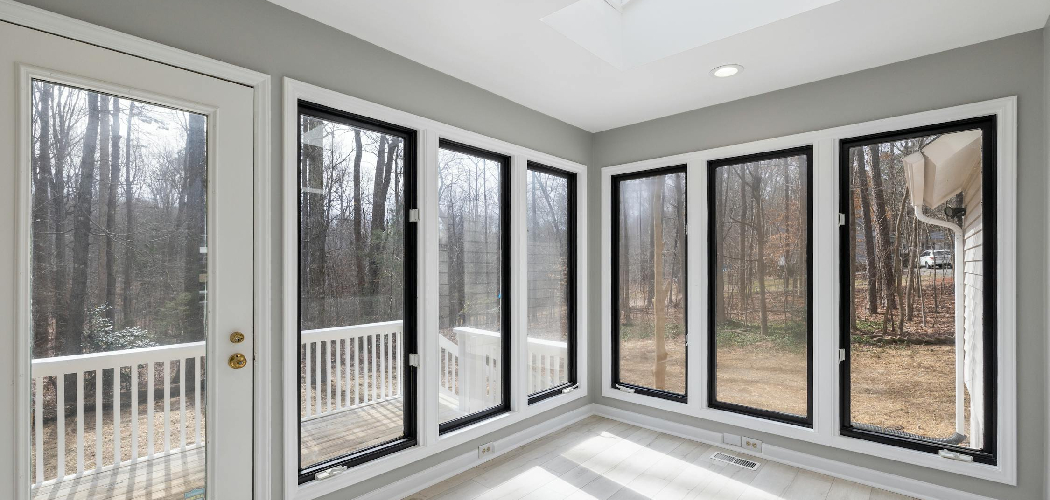Properly functioning sliding doors are essential for both convenience and security in any home or office space.
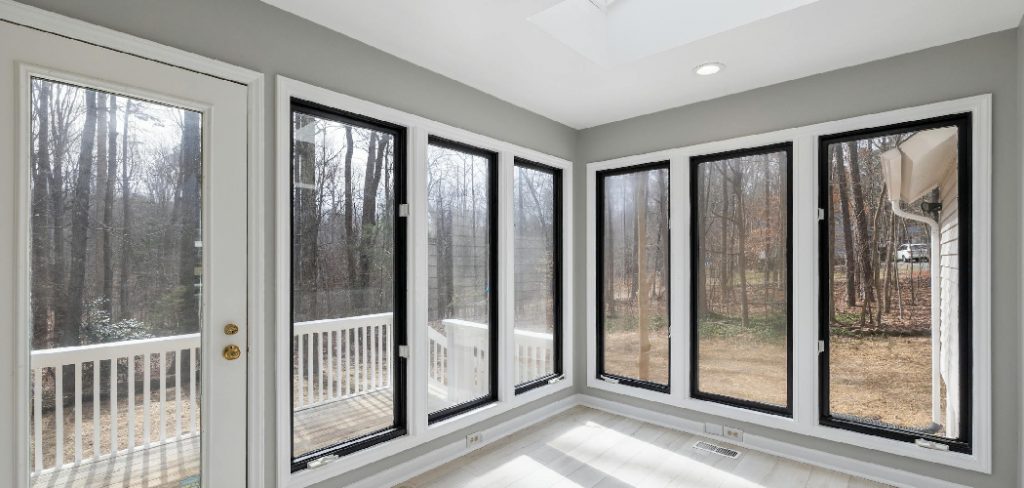
When these doors operate smoothly, they provide easy access and efficient use of space while also ensuring safety and privacy.
However, common issues such as difficulty sliding, misalignment, and noise can disrupt their functionality, leading to frustration and potential security concerns.
Understanding how to adjust top hung sliding door is crucial for resolving these problems. This guide will walk you through the process of assessing and adjusting your top-hung sliding door to restore its smooth operation.
By identifying and addressing issues with the rollers, track, and guide rails and ensuring proper lubrication and maintenance, you can ensure your sliding door remains a reliable and efficient feature of your space.
Regular adjustments and maintenance improve functionality and extend the door’s lifespan, providing lasting convenience and peace of mind.
Understanding Top-Hung Sliding Doors
Top-hung sliding doors operate by being suspended from a track that is mounted on the top frame of the door opening. The door itself hangs from this track, allowing it to glide smoothly and efficiently along the path defined by the track.
This mechanism eliminates the need for a bottom track, providing a clear and unobstructed floor space, which can be particularly advantageous in areas with high foot traffic.
The primary components of a top-hung sliding door include the track, rollers, adjustment screws, and guide rails. The track, positioned at the top, is the guiding path for the door’s movement.
The rollers, attached to the top edge of the door, facilitate the sliding motion by rolling along the track. Adjustment screws, usually found on the rollers, enable fine-tuning of the door’s height and alignment.
Guide rails at the bottom help maintain the door’s lateral stability and prevent swaying. Regular maintenance of these components is vital for ensuring smooth operation.
This includes keeping the track clean from debris, periodically lubricating the rollers, and checking the door’s alignment. Consistent upkeep not only enhances the sliding door’s functionality but also prolongs its lifespan, ensuring reliable performance over time.
Tools and Materials Needed
- List of tools: screwdriver, wrench, level, lubricant (silicone spray)
- Optional: step ladder, pliers, safety gloves
Assessing the Issue
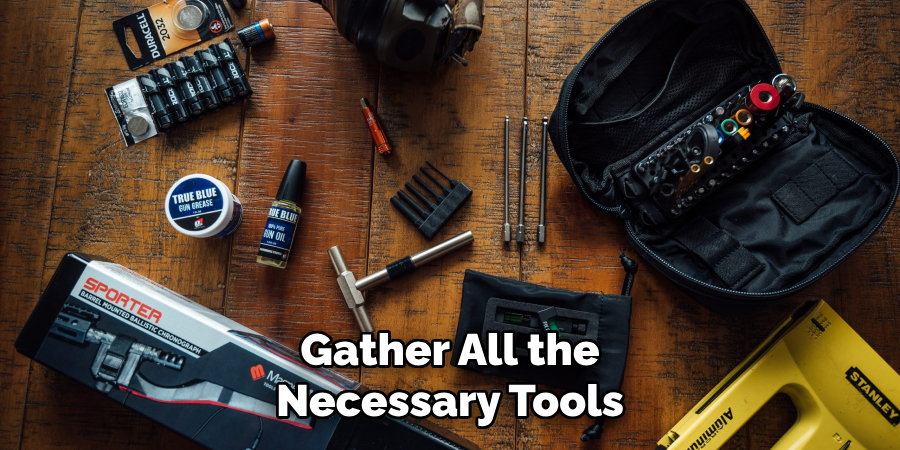
Proper assessment of your top-hung sliding door is the first step towards ensuring it functions smoothly and efficiently. Identifying signs that the door needs adjustment is crucial.
Common indicators include uneven sliding where the door does not move smoothly along the track, sticking which causes significant resistance during operation, excessive noise that signals potential friction or obstruction, and visible gaps that may compromise both the security and insulation of the space.
To inspect for these issues, start by examining the track and rollers. Look for any dirt, debris, or physical damage that might obstruct the door’s movement. A debris build-up can cause the door to stick or slide unevenly, while damaged rollers or track components can lead to misalignment and noise during operation.
leaning the track regularly and replacing any damaged elements is essential. Next, check the door’s alignment with the frame. Misalignment can result from issues with the rollers or the mounting brackets. Using a spirit level, determine if the door is level horizontally and vertically.
Any deviations might indicate that adjustments are needed to the rollers or track to restore proper alignment. By carefully assessing these areas, you can identify and address the root causes of your sliding door issues, setting the stage for effective adjustments.
How to Adjust Top Hung Sliding Door: Adjusting the Rollers
Step-by-Step Guide to Adjusting the Rollers
Adjusting the rollers on a top-hung sliding door is a straightforward process that can significantly improve the door’s functionality. Follow these steps to ensure proper adjustment:
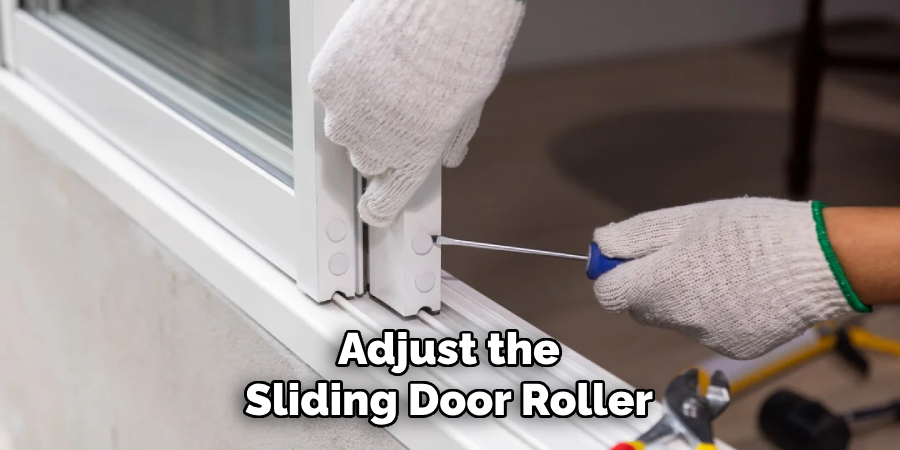
- Locating the Adjustment Screws on the Rollers
- The first step is to locate the adjustment screws. These screws are usually found at the bottom or sides of the door, depending on the door model. Refer to the door manufacturer’s manual for the exact location if necessary.
- Using a Screwdriver or Wrench to Turn the Screws and Raise or Lower the Door
- Once you have located the adjustment screws, use a screwdriver or wrench to turn them. Turning the screws clockwise typically raises the door, while turning them counterclockwise lowers it. Make slight adjustments to avoid over-correcting.
- Ensuring the Door is Level by Checking with a Spirit Level
- After making an initial adjustment, use a spirit level to check the level of the door. Place the spirit level along the top edge of the door to ensure it is horizontally level. If the door is not level, continue to adjust the screws until the desired alignment is achieved.
- Testing the Door Movement After Adjustment and Making Fine Adjustments as Needed
- Test its movement once the door is level by sliding it back and forth along the track. If the door still experiences resistance or does not glide smoothly, make fine adjustments to the screws. It may take a few iterations to achieve optimal performance.
- Tips for Ensuring Even Weight Distribution Across the Rollers
- Ensure that both sides of the door are adjusted evenly to distribute the door’s weight across all rollers. Uneven adjustment can cause undue strain on the rollers and track, leading to further misalignment or damage.
- Periodically check the rollers and screws for wear and tear, and replace any components that appear damaged to maintain smooth operation.
- By following these steps, you can effectively adjust the rollers on your top-hung sliding door, ensuring a smooth and efficient operation.
Lubricating Moving Parts
Importance of Lubricating the Track and Rollers for Smooth Operation
Lubricating the track and rollers is essential for maintaining the smooth operation of your top-hung sliding door. Regular lubrication reduces friction, preventing wear and tear on the components.
It also ensures that the door glides effortlessly along the track, minimizing noise and resistance during use.
Applying Silicone Spray Lubricant to the Track and Rollers
To lubricate the moving parts, use a silicone spray lubricant, which is ideal for sliding doors as it doesn’t attract as much dirt and grime as other lubricants might.
Begin by thoroughly cleaning the track and rollers to remove any built-up debris. Then, apply the silicone spray evenly along the top track and directly onto the rollers. Ensure that all areas of contact are adequately coated.
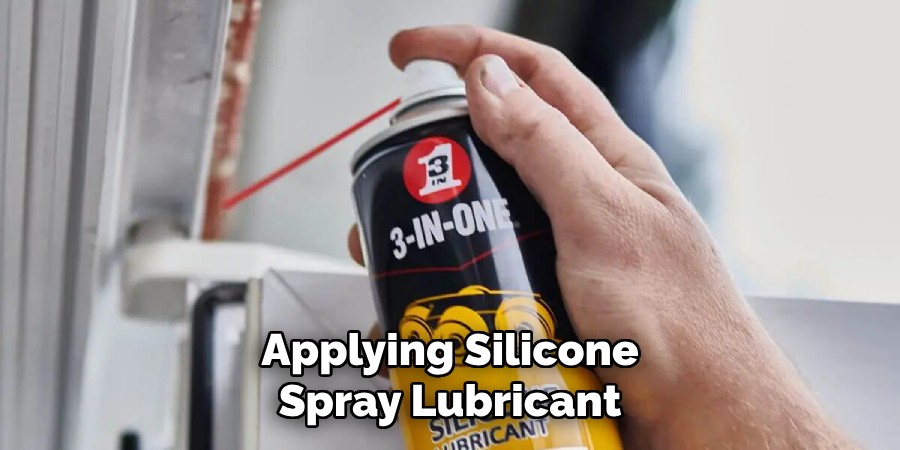
Wiping Away Excess Lubricant to Prevent Dirt Accumulation
After applying the lubricant, wipe away any excess with a clean cloth. This step is crucial to prevent dirt and dust from accumulating, which could negate the benefits of lubrication and cause the door to stick again.
By maintaining clean, well-lubricated components, you ensure the ongoing smooth operation of your sliding door.
Checking the Guide Rails
Inspecting the Guide Rails at the Bottom of the Door
Regular inspection of the guide rails at the bottom of your top-hung sliding door is crucial for smooth operation.
Begin by carefully examining the guide rails for any signs of wear, damage, or debris buildup. Dirt and debris can obstruct the door’s movement, causing it to stick or slide unevenly.
Ensuring the Guide Rails are Properly Aligned and Secure
Ensure the guide rails are properly aligned and securely fastened to the floor. Misalignment can lead to poor door performance and increased strain on the track and rollers. Verify that the guide rails are level and straight using a spirit level.
Adjusting the Guide Rails if Necessary to Ensure Smooth Sliding
If misalignment is detected, adjust the guide rails as necessary. Loosen the screws securing the guide rails, realign them to ensure they are straight and level, and then retighten the screws.
Test the door’s movement after making adjustments, ensuring it glides smoothly along the track.
Troubleshooting Common Issues
Addressing Persistent Misalignment or Sticking
If your top-hung sliding door continues to misalign or stick after adjustments, further investigation is necessary.
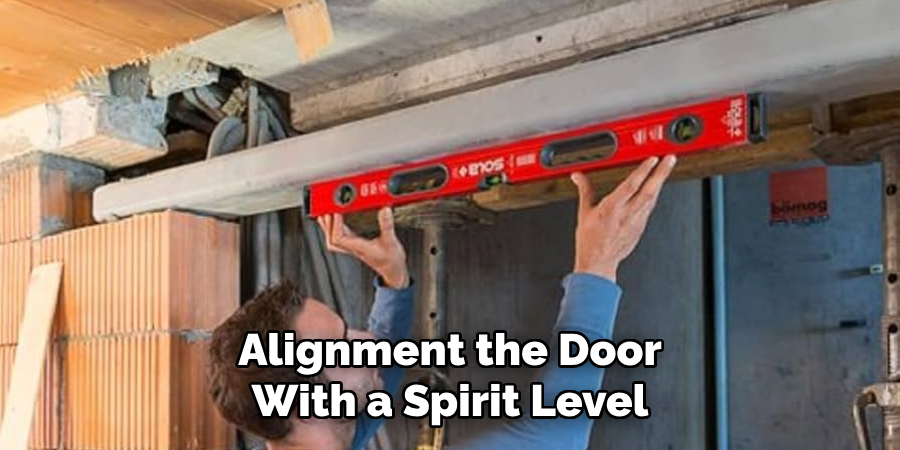
Start by reassessing the door’s alignment with a spirit level to ensure it is level both horizontally and vertically. Misalignment often indicates underlying issues such as damaged rollers or track components.
Checking for Damaged Rollers or Track and Replacing if Necessary
Inspect the rollers and track for any signs of damage or excessive wear. Damaged rollers can hinder smooth operation and may need replacing to restore functionality.
Likewise, check the track for any dents, bends, or obstructions. Replace or repair any damaged components as needed to maintain the door’s performance.
Dealing with Noise Issues
Excess noise during door operation often results from improper lubrication or loose components. Reapply silicone spray lubricant to the track and rollers to reduce friction and minimize noise. Additionally, check and tighten all screws and brackets to eliminate any rattling or vibrating parts.
Ensuring All Components are Properly Lubricated and Tightened
Regular maintenance is key to preventing issues. Ensure all moving parts are adequately lubricated and that all screws and fasteners are securely tightened. Periodically check for any signs of wear and address them promptly to avoid further complications.
Consulting the Door Manufacturer’s Manual for Specific Instructions and Tips
Refer to the door manufacturer’s manual for specific troubleshooting steps and detailed maintenance tips. The manual provides valuable guidance tailored to your door model, ensuring effective and precise adjustments. Following manufacturer recommendations helps maintain optimal door functionality.
Regular Maintenance Tips
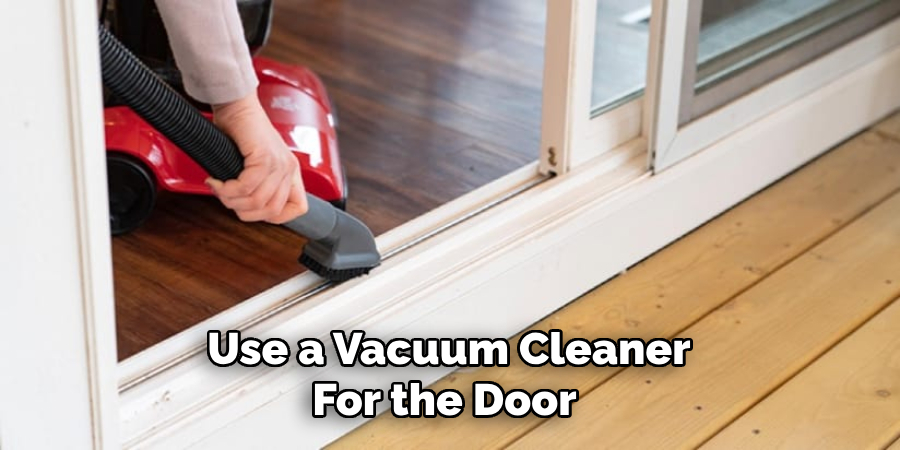
Importance of Regular Inspection and Maintenance for Long-Term Functionality
Regular maintenance of your top-hung sliding door is essential for ensuring its long-term functionality and smooth operation. By following a consistent maintenance schedule, you can prevent common issues such as misalignment, sticking, and noise that can arise from daily use.
Cleaning the Track and Rollers Periodically to Prevent Buildup
Periodically clean the track and rollers to remove dust, dirt, and other debris that can accumulate over time. Use a vacuum or a soft brush to clear out any obstructions along the track.
Wiping down the rollers and track with a damp cloth will also help maintain a clear and smooth path for the door to glide on.
Checking and Tightening Screws and Brackets Regularly
Regularly inspect all screws and brackets to ensure they remain tight and secure. Loose screws can lead to misalignment and noise during operation.
Use a screwdriver to check each fastener and give it a slight turn to ensure it’s properly tightened. This simple step can significantly extend the lifespan of your sliding door.
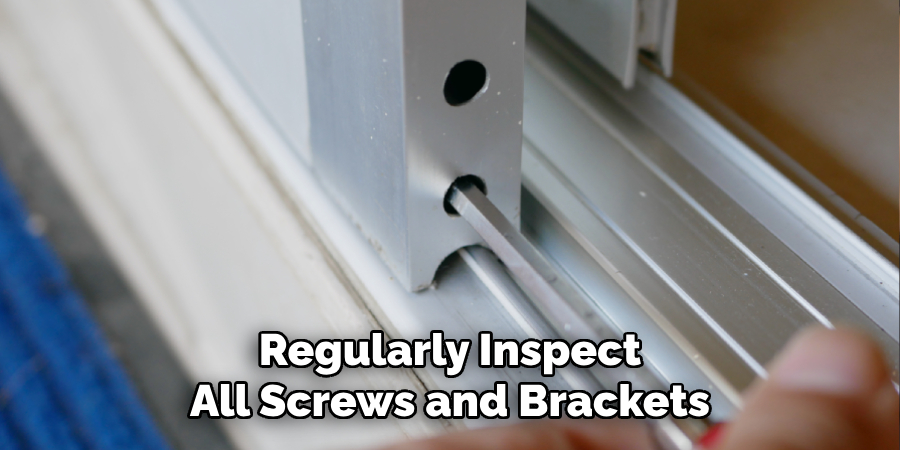
Conclusion
In conclusion, proper adjustment and maintenance of top-hung sliding doors are crucial for optimal performance and longevity. Consistently checking and fine-tuning the components prevents common issues such as misalignment, sticking, and noise and ensures a seamless and quiet operation.
Regularly cleaning the track and rollers, lubricating moving parts, and tightening screws and brackets can significantly reduce wear and tear, extending the lifespan of your door.
By following these simple steps on how to adjust top hung sliding door systems, you can keep your door functioning smoothly for years to come.
Remember, a well-maintained sliding door adds both convenience and aesthetic value to your home, making it a worthwhile investment in your property’s overall comfort and appeal.

